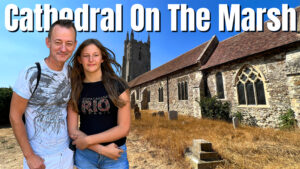The History of Hedingham Castle and The De Vere Family
Castle Hedingham is one of England’s most impressive Norman keeps, and it has a long and very interesting history, The village was granted to one of William, duke of Normandy’s lords, one Aubrey de Vere. Although he and his descendants built a number of castles at various locations in their extensive lands, they chose Hedingham as their primary seat; by around 1140 the third Aubrey de Vere had built the stone keep that we see today. The keep sits atop a high earth ringwork, with an adjacent inner bailey now occupied by an 18th Century country mansion, where the present owners reside. An outer bailey extended well into the modern village, making the whole complex very large; presumably, this was abandoned as the castle’s defensive value waned and the village expanded. The castle also constituted a complete infrastructure itself – the keep was but one element, and was complemented by stables, a granary, defensive walls and towers and residential accommodation for people of widely varying status. The keep is nearly square, a common shape for Norman keeps. The east and west sides are 53 ft (16 m) long and the north-south sides about 58 ft (18 m). The main part of the keep stands more than 70 ft (21 m) tall, and the turrets rise an additional 15 to 25 ft (4.6 to 7.6 m) above the parapets, commanding the countryside around it from its elevated position atop the ringwork. The walls are about 11 ft (3.4 m) thick at the base and average 10 ft (3.0 m) thick at the top. They are constructed from flint rubble bound with lime mortar, but, very unusually for an Essex castle, are faced with ashlar stone transported from a quarry in Barnack, Northamptonshire. The keep has five floors including the Great or Banqueting Hall with a great fireplace and a central arch extending two stories. THE DE VERES OF HEDINGHAM Throughout the Norman and medieval periods the de Veres were at the forefront of national politics. They were traditionally Lord Great Chamberlains to the reigning monarch, and many kings and queens visited Hedingham Castle, including Henry VII, Henry VIII, and Elizabeth I. The 2nd Earl went on Crusade with Richard I, and the 3rd Earl was among the leaders of the barons who forced king John to sign the Magna Carta. King John took his revenge, and in 1216 his armies seized Hedingham after a brief siege. The following year the royal forces were ousted by the Dauphin of France and the de Veres regained their castle. During the Wars of the Roses John de Vere, the 13th Earl of Oxford, supported the Lancastrian cause and helped lead Henry VI’s armies at the Battle of Barnet in 1471. Not surprisingly Edward IV seized his estates. De Vere helped Henry VII defeat Edward’s successor, RichardIII, and the grateful Tudor king restored his lands and titles. Henry invited de Vere to stand as godfather to his eldest son, Prince Arthur. The Earl entertained the new king at Hedingham, but according to a tale related by Sir Francis Bacon, de Vere made the mistake of flaunting his wealth by showing off his huge number of retainers. Henry’s strict laws made such a large number of retainers illegal, and the king fined de Vere a vast amount of money. The Earl had enough wealth to pay the fine and transform much of his medieval castle to a palatial Tudor residence. Hardly any trace of this grand house remains, save for a red brick bridge between the castle motte and outer bailey. The 15th Earl attended Henry VIII at the Field of the Cloth of Gold and held the crown during the coronation of Anne Boleyn as Henry’s second queen. The 16th Earl led Elizabeth I to her coronation, and his Countess served as Elizabeth’s maid of honour. The 17th Earl de Vere was one of Elizabeth’s great favourites and a noted poet. Just how talented a poet the Earl was depends on which conspiracy theory you adhere to; repeated theories have surfaced that the Earl actually wrote the plays and poetry attributed to William Shakespeare. This theory was dramatised in the 2011 film Anonymous, starring Rhys Ifans. Apart from members of the de Vere family, there has been at least one notable death at Hedingham Castle, Matilda, wife of King Stephen, died of fever here on 3 May 1152. #hedinghamcastle #devere #medieval #castle
Yhana and I will mention your support in one of our upcoming videos. * ? https://www.buymeacoffee.com/stephena… * ? http://www.patreon.com/stephenandyhana *
- Published: 24 June 2022
- Location: Castle Hedingham, Essex
- Duration: 11:30
- Photography – Stephen Robert Kuta
- Written by – Stephen Robert Kuta
Music –
Music Licensed by Epidemic Sound
*** If you enjoy our content why not support our creative process on Patreon. *** ? http://www.patreon.com/stephenandyhana ***



